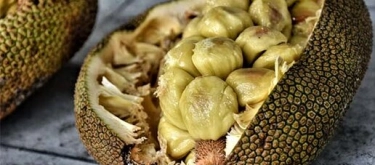Pawpaw (Asimina): Taste Profile, Aroma, Benefits and Health Risks
Pawpaw, also known by its scientific name Asimina triloba, is a unique fruit native to North America. Often described as a “forgotten fruit,” pawpaw has been gaining renewed attention for its custard-like texture and tropical flavor profile. The pawpaw fruit is notable for its creamy texture and rich, sweet taste, reminiscent of a blend of banana, mango, and melon. This article explores the flavor characteristics of pawpaw, its culinary applications, health benefits, and tips for selecting and storing it.
What does Pawpaw (Asimina) taste like?

Primary Flavor Characteristics
Pawpaw has a tropical, custard-like flavor that is both sweet and complex. The taste is often described as a blend of banana, mango, and melon, with a hint of vanilla. Its richness and sweetness make it stand out from other fruits native to temperate climates.
Aromatic and Taste Nuances
The aroma of pawpaw is fruity and fragrant, with hints of tropical sweetness. The fruit has a creamy, custard-like texture, making it a unique experience compared to other temperate fruits. The flavor is best when the fruit is fully ripe, offering a balance of natural sugars and subtle acidity.
Scientific Description of Taste and Aroma
- Aroma: Fruity, tropical, with hints of banana and vanilla.
- Taste: Sweet, creamy, with tropical flavors reminiscent of banana, mango, and melon.
- Texture: Smooth and custard-like, with soft, creamy flesh and large seeds.
In-Depth Flavor Analysis of Pawpaw
Underlying Flavor Notes
Pawpaw’s flavor profile offers a layered experience, with key characteristics including:
- Sweet Tropical Notes: The primary flavor is sweet and tropical, with distinct banana-like notes balanced by hints of mango and melon.
- Vanilla Undertones: There is a subtle vanilla flavor, which adds warmth and depth to the taste.
- Custard-like Texture: Pawpaw’s smooth, creamy flesh enhances its dessert-like quality, making it ideal for sweet applications.
Impact of Ripeness on Flavor
- Under-ripe Pawpaw: Firm and less sweet, with a mild astringency that can make the flavor less enjoyable.
- Fully Ripe Pawpaw: Soft and custard-like, with a pronounced sweetness and rich tropical flavor.
Textural Qualities
Pawpaw has a creamy, custard-like texture, which is similar to that of a ripe avocado or custard apple. This unique texture makes it ideal for blending into desserts and smoothies, where it adds both flavor and body.
Culinary Uses of Pawpaw
Primary Uses
- Fresh Eating: Pawpaw is often enjoyed fresh, scooped out of the skin, for a creamy and satisfying treat.
- Smoothies and Shakes: Pawpaw’s custard-like texture blends well in smoothies and milkshakes, adding a naturally sweet, tropical flavor.
- Desserts: Pawpaw is ideal for desserts like ice cream, sorbets, and custards due to its creamy texture and sweetness.
- Baking: Pawpaw can be used as a substitute for bananas in recipes like bread, muffins, and cakes, adding a unique tropical flavor.
- Jams and Preserves: The fruit can also be used to make jams and preserves, capturing its sweetness and tropical aroma.
Ideal Pairings for Pawpaw
- Spices: Cinnamon, nutmeg, and vanilla complement pawpaw’s tropical sweetness, enhancing its dessert-like qualities.
- Coconut and Almond Milk: These milks bring out pawpaw’s creaminess and add a subtle richness to smoothies and desserts.
- Honey and Maple Syrup: Natural sweeteners like honey and maple syrup pair well with pawpaw, enhancing its natural sugars.
- Nuts: Almonds, pecans, and walnuts add crunch and contrast to pawpaw’s soft texture in baked goods and salads.
- Citrus: Lime and lemon add a refreshing acidity that balances the sweetness of pawpaw in desserts and beverages.
Health Benefits of Pawpaw
Key Nutrients and Benefits
- Vitamin C: Pawpaw is a good source of vitamin C, supporting immune health and promoting skin vitality.
- Vitamin A and Carotenoids: The fruit contains beta-carotene, which supports eye health and skin function.
- Magnesium and Potassium: These minerals are essential for heart health and muscle function, helping to regulate blood pressure.
- Antioxidants: Pawpaw has a range of antioxidants that protect cells from oxidative damage and reduce inflammation.
- Fiber: High in dietary fiber, pawpaw supports digestion and helps maintain healthy blood sugar levels.
Potential Precautions
- Allergy Sensitivity: Some people may be sensitive to compounds in pawpaw and may experience skin irritation or mild stomach discomfort.
- Seeds and Skin: The seeds and skin contain compounds that are potentially toxic if ingested; it’s important to eat only the flesh of the fruit.
- Ripeness Sensitivity: Overly ripe pawpaw can develop an off flavor and odor, so it’s best consumed when just ripe.

Tips for Choosing and Storing Pawpaw
How to Choose Quality Pawpaw
- Firmness and Skin Color: Look for pawpaws that have softened slightly and may have a few dark spots on the skin, which indicate ripeness.
- Aroma: A ripe pawpaw will have a sweet, fruity aroma, especially near the stem.
- Touch: When gently pressed, the fruit should yield slightly, indicating that it is ready to eat.
Storage Recommendations
- At Room Temperature: Ripen pawpaws at room temperature until they are soft and aromatic.
- In the Refrigerator: Once ripe, store pawpaw in the refrigerator to extend its freshness by a few days.
- Freezing: Pawpaw flesh can be scooped and frozen for later use in smoothies and desserts, preserving its flavor and texture.
Fun Facts About Pawpaw
- Native to North America: Pawpaw is the largest edible fruit native to North America and grows in regions from the Midwest to the Eastern United States.
- Nicknamed the “Poor Man’s Banana”: Due to its similar taste, pawpaw has been compared to bananas and is sometimes called the “Poor Man’s Banana.”
- Short Shelf Life: Pawpaw has a limited shelf life and is rarely found in stores; it’s often foraged or grown by local farmers.











